OTTO
SOGLOW AND THE LITTLE KING
The
Silent Runs Deep
(with
an Apostrophe to Naked Ladies in Their Baths)
OTTO
SOGLOW EARNED HIS NICHE in the pantheon of cartooning by producing the first
long-running syndicated strip to employ pantomimic action. But what he really
wanted was to be an actor. 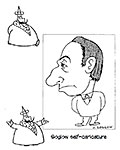 Born December 23, 1900, in the Yorkville district of New York City,
the son of a German Jewish house painter and a cook, young Otto went to P.S. 77
at 86th Street and First Avenue, then completed only a year at
Stuyvesant High School. “I had a sister,” he once explained, “—and I had to go
to work.” Born December 23, 1900, in the Yorkville district of New York City,
the son of a German Jewish house painter and a cook, young Otto went to P.S. 77
at 86th Street and First Avenue, then completed only a year at
Stuyvesant High School. “I had a sister,” he once explained, “—and I had to go
to work.”
Deferring
a dream of a thespian future, he took a succession of odd jobs—packer, shipping
clerk, dishwasher, and errand boy. At one time, he famously had a job painting
forget-me-nots on baby rattles. He also worked as a switchboard operator—but
only for two hours. Plugging away at the switchboard, he made an unholy tangle
of telephone lines, and, realizing how hopeless the mess was, he simply put on
his cap and walked out.
Throughout
all these travails, he kept his acting ambition uppermost in mind. He regularly
wrote to motion picture companies, offering his services. “Naturally, they paid
no attention because I was just a kid,” he said later. “But one day they held a
parade through the streets to a movie convention at Grand Central Palace, and I
followed it—and landed a job! They let me sell programs at the convention.”
Soon
after World War I, he enrolled in the Art Students League, where he fell under
the influence of such instructors as John Sloan, George Luks, and Robert
Henri, founders of the “ashcan school” of American art. Says Jared Gardner
in his introduction, “The American King,” to Cartoon Monarch: Otto Soglow
and the Little King: the ashcan artists “rejected the gentle soft focus of
American impressionism in favor of gritty, political, urban realism. The world
they painted (and taught their students to paint) was a world Soglow knew well:
tenements, bars, subways, and midnight streets. Soglow’s mentors pointed out a
way to bring together his creative ambitions with his own personal experiences
and observations. The childhood Soglow would fondly recall many years
later—‘gang fights with kids from neighboring streets, stealing potatoes from
vegetable stands and toasting them in cans which swung by a wire’—was the stuff
of art at the hands of Sloan and his colleagues.”
Sloan
contributed illustrations (unfunny cartoons, Gardner says) to the leftist The
Masses, for which he served on the board, and he undoubtedly encouraged
Soglow to submit drawings and cartoons in 1922 to The Liberator, successor to The Masses. Soglow’s work for this magazine, and for The
New Masses in 1926-28, was clearly ashcan inspired. 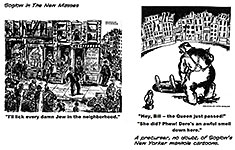 His first published
effort in a freelance illustration career, however, was earlier, for Lariat
Magazine, a cowboy pulp. His first published
effort in a freelance illustration career, however, was earlier, for Lariat
Magazine, a cowboy pulp.
“Soglow
had never been out of New York,” reported the King Features promotional booklet Famous Artists and Writers, “but his cowboys were real authentic.”
Soglow
once said he found his first job by thumbing the telephone directory and
writing down the names of all the publications. Said he: “I took a handful of
drawings and started to call on publishing houses. I started at the Battery and
worked my way uptown from there. The following day, I started from the street I
left off the previous day.”
When
he got to 34th Street, he landed a job for a publisher of cheap pulp
magazines (perhaps Lariat Magazine). “I received seven dollars for my
first published drawing,” he recalled for Jerry Robinson in The Comics. “From
then on, I decided to become a cartoonist.”
By
1925, when Soglow joined the art staff at the New York World, he had
abandoned illustration in favor of cartooning. At the World for about a
year, he produced a series of satiric comic strips; he also continued to
freelance, contributing cartoons to Life, Judge, The New Yorker, Collier's, and other leading magazines. On October 11, 1928, he married Anna Rosen; they
had one daughter, Tona (whose name was composed of the last two letters of her
parents’ names).
Soglow’s
first cartoon in The New Yorker appeared in November 1925, just eight
months after Harold Ross launched the magazine. As a selection of his New
Yorker work of the late 1920s shows, he eschewed the dark and grimy ashcan
approach entirely for Ross’s urbane periodical. He was doing both single-panel
gag cartoons, which he rendered with a simple line in a surrealistic manner,
amply toned with gray wash, and comic strips, usually in pantomime, drawn even
more simply, the clear forerunner of his most celebrated work. But at the same
time, as we saw in our previous visual aid, he was doing ashcan-style cartoons
and illustrations for The New Masses.
In
late 1928, Soglow started doing the cartoons that first increased his
visibility in The New Yorker—the so-called “manhole” cartoons. The first
of these was published in the magazine’s December 15 issue. The same drawing
with a succession of different captions would appear regularly for some months
thereafter. 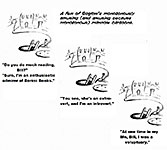
Then
in 1930 with the June 7th issue of the magazine, Soglow’s life
changed forever. The revolution was brought about by a full-page comic strip he
drew that featured a diminutive albeit rotund mute monarch. Ross liked the
character and the concept and asked Soglow to produce another. Ross was picky,
reportedly accepting at the miserly rate of six cartoons for every eight Soglow
produced, but the “little king” was soon a regular feature in the magazine, and
Soglow had inadvertently begun his life’s work.
Pantomimic
cartoon comedy was scarcely a novelty at The New Yorker: others of its
regular cartoonists—Al Freuh, Gardner Rea, Rea Irvin, Gluyas Williams, even
Peter Arno (to name a few)—had been doing pantomime comic strips for years.
But Soglow’s silent king was different: he had an
endearing personality. He seemed not to enjoy the pomp and circumstance of his
station in life: this king was always playing hooky, indulging the small boy
within him. And we smiled at his juvenile enjoyments.
But
Soglow’s labors were not confined exclusively to a cartoon throne room. He
continued to freelance his work in other publications, and in 1931, a number of
his previously unpublished cartoons of a mildly risque sort appeared in a
compilation of kindred comedy entitled The Stag at Eve, which included
cartoons by numerous other worthies—chiefly, William Steig, Gardner Rea,
Leonard Dove, Barbara Shermund, Raeburn Van Buren.
Meanwhile,
the popularity of the Little King had attracted attention at the Hearst Works,
leading to the offer of a syndication contract with King Features. Soglow
accepted the deal, but the arrangement did not proceed immediately. According
to report, Soglow was under contract to The New Yorker to produce The
Little King, and before he could take up with King Features, that contract
had to expire. While waiting for this eventuality devoutly to be wished, Soglow
produced The Ambassador as a place holder in pantomime at the syndicate,
starting May 28, 1933.
The
Ambassador seems, at first blush, a character very similar to the Little King:
rotund in physique and August in demeanor, the Ambassador starts each weekly
adventure with appropriate pomp but inevitably finishes in a wholly incongruous
situation. Hence, the comedy. But the Ambassador was not very likeable. No
mischievous little boy lurked within the Ambassador. Nor did the incongruity of
the strips’ endings seem to reveal the fraud in the ambassadorial milieu. The
Ambassador seems, in comparison to the oft childish King, haughty rather than
humble.
The
fascinating aspect of The Ambassador resides in the inventiveness of
Soglow’s layouts in the earliest of the strips. It is as if the cartoonist,
faced with a full-page format in color for the first time, felt the need to
experiment with the form itself. 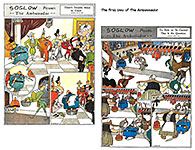
Soglow
had been doing full-page strips for the Little King at The New Yorker,
so it wasn’t the format itself that inspired such wild invention: it may have
been the presence of color that prompted him to play with the form. Or perhaps,
more likely, it was the greater expanse of a newspaper page, offering more
space for playing around with shapes and their array than the smaller New
Yorker page size.
But
the experimental phase didn’t last long: by the fall of its inaugural year, the
strip had assumed the traditional grid format of all Sunday comic strips.
Presumably, a standard format is easier for newspaper editors to work with; an
unconventional format, even if it fills over-all the customary rectangular
shape on the page, taxes the editorial patience, which, we assume, is always in
short supply when it comes to comics. (At about the same time—and for about the
same reason—George Herriman’s lyric Krazy Kat, which Sundays were
often a krazy kwilt of panels, many adrift without borders, was forced into a
grid of bordered panels.) The Ambassador lasted only fifteen months,
ending September 2, 1934.
By
then, the King’s reign at The New Yorker was over: it concluded
September 1. A week later, he was crowned into national newspaper syndication
on September 9, 1934, as a Sunday-only comic strip.
The
Little King is renowned for the utter simplicity of Soglow's drawing style
and for the title character's humility and ingenuity—and silence. Soglow's
drawings are minimalist art, diagrams in plane geometry. The body of the
Little King, a short fat fellow, is the simplest of circles. The humor of the
feature is built upon contrast: instead of behaving like a crowned head of
state, the Little King acts like an ordinary citizen (or an adventurous boy).
When
he leaves his castle because it is about to be besieged, he pauses on his way
out to leave a note for the milkman. He confers knighthood upon a courtier but
afterwards holds out his palm so the new knight can pay him a fee. He is often
more mischievous youth than reigning monarch: he is not above indulging in a
juvenile prank. He throws out the first ball to begin the baseball season; when
the ball goes over the fence and breaks a window in a nearby house, the Little
King runs away like any neighborhood kid. When the royal dishwasher quits,
leaving behind an enormous stack of dirty dishes, the Little King tackles the
problem by putting on his swim suit and taking the entire stack of dishes with
him into the swimming pool. The over-all effect of such adventures is to
ridicule pomposity while championing the joys of ordinary life. But the Little
King was not so much a satirical strip as it was a playful one. 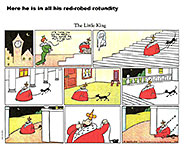
The
simple plots of these gags work because they unfold in pantomime. The Little
King never speaks; others in the strip might say a few words occasionally in
order to clarify a situation leading to the punchline, but the King is forever
mute. With little or no verbiage to prepare us for what is coming, we must
rely entirely upon the pictures. And the visuals "narrate" the "story"
one plot increment at a time, keeping us in suspense about what the King is up
to until we reach the final panel where the "mystery" is revealed,
the surprise and/or the King's inventiveness provoking our laughter.
For
a short time during the unpleasantness in Europe in the early 1940s, Soglow
introduced a new character in the strip—Ookle the Dictator, a foil for the
Little King and a send-up of the various dictators who populated the world
stage during World War II. Ookle started as a junk dealer, but when he won a
game of poker with the King, he assumed command of the kingdom. Unlike the
King, Ookle spoke; I’m not sure that the King always listened. In fact, the
comedy of this series lay in the King’s ignoring or frustrating the Dictator’s
commands in favor of a more personal momentary pursuit. 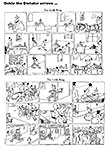
In
addition to producing The Little King, Soglow did Sentinel Louie, another Sunday pantomime strip. Louie began as the third-page “topper”
running at the top of The Ambassador page. When The Little King started, it inherited Louie, which continued until some time in 1943, by
which time, newspapers had started to reduce the size of Sunday strips,
contributing the saved newsprint to the war effort for use elsewhere as gun
fodder. 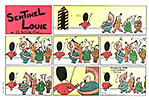 In
1946, Soglow produced Travelin’ Gus, yet another pantomime
enterprise—this one about a streetcar driver. In
1946, Soglow produced Travelin’ Gus, yet another pantomime
enterprise—this one about a streetcar driver.
Wholly
unnoticed by histories of the medium and therefore rare enough to justify our
attention here, this strip lasted only a few months, from February (perhaps the
10th) until October 6, and we can see why: Gus lacked the endearing
personality traits of the Little King. But the humor employs the same basic maneuver—building
a mystery for several panels and then revealing an explanation in the last
panel.
The explanation, the ingenuity of the contrivance, makes us
chuckle. This approach to humor can work only with a “silent” strip: the
mystery could not easily (or persuasively) be maintained if any of the
characters spoke.
Throughout
a long career, Soglow continued to draw gag cartoons for magazines and
regularly illustrated columns and features in such periodicals as The
Saturday Evening Post; he drew decorative comic spot illustrations for The
New Yorker’s “Talk of the Town” column until 1972. He also illustrated
some 30 books, among which numbered some of his own cartoon collections: Pretty
Pictures (1931), Everything’s Rosy (1932), Another Ho Hum: More
Newsbreakers from The New Yorker (1932), The Little King (1933), Soglow’s
Confidential History of Modern England (1939), and, with D. Plotkin, Wasn’t
the Depression Terrible? (1934).
The
Little King was discontinued with the release for July 20, 1975, Soglow
having worked that far ahead before he died in his New York City apartment,
April 3, 1975. A founder of the National Cartoonists Society in 1946, Soglow
served as its president 1953-54.
He was
named “cartoonist of the year,” collecting a Reuben statuette, in 1966, and in
1972, he was the second recipient of the Society’s Elzie Segar Award “for
unique and outstanding contributions to the profession of cartooning”—a
recognition, doubtless, of his long service to the club as much as for The
Little King.
And
in NCS, he at last achieved his life-long ambition: he acted often in
vaudevillian skits performed at the Society’s dinners. He did similar turns at
events for the Society of Illustrators, of which he was also a member. He even
dressed up as the Little King for various after-dinner entertainments hither
and yon through the city. According to those who knew him, Gardner says, he is
remembered better as a performer than as a cartoonist. But for us hoipolloi, he
will be fondly remembered for the pantomime routines of a diminutive round
monarch in a red robe.
Sources.
Apart from the NCS (member) Albums and a few syndicate press releases, there is
no readily available biographical information about Otto Soglow except that
retailed (happily in carefully researched detail) by Jared Gardner in Cartoon
Monarch: Otto Soglow and the Little King (2012). The Little King is
discussed briefly in the standard histories of the medium— Comic Art in
America by Stephen Becker (1959) and The Comics by Coulton Waugh
(1947); Ron Goulart’s Encyclopedia of American Comics (1990) and The
Funnies (1995); Jerry Robinson’s The Comics: An Illustrated History of
Comic Strip Art 1895-2010 (2011), which, alas, assumes that the Little
King grew out of The Ambassador. Dates of Soglow’s various strip
creations are found in Allan Holtz’s American Newspaper Comics: An
Encyclopedic Reference Guide (2012).
Return to Harv's Hindsights |